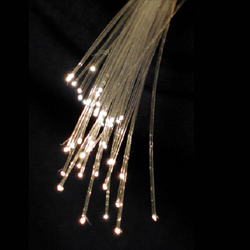An easy way to understand how fiber optics works: visualize peering into a very long tube, the inside of which is coated with a perfectly mirrored surface. One mile away, at the opposite end, a friend shines a bright flashlight into the tube.
Because the tube is internally coated with a perfect mirror, you will see his light perfectly at your end, regardless of how many twists and turns the pipe takes. If your friend flashes the light off and on repeatedly (simulating a binary off/on electronic pulse), you’ll see this “digital” light data at your end of this internally mirrored pipe – literally, at the speed of light.
Most optical fibers for communications applications are made of silica glass that consists of a solid inner core surrounded by a cladding layer of glass with a lower index of refraction than the core. The boundary between the core and the cladding causes an internal reflection so that light entering the core at one end remains trapped until it emerges at the other end.
Light sent through the fiber is most commonly generated by either an LED or a laser. These specialized optical transmitters “flash” the light to represent digital binary data, either on or off. The modulated light is sent at very fast data transmission rates, typically from 125 Mbs (millions of bits per second) to 10 Gbs (billions of bits per second) – and faster. The light “data” passes through the entire length of the fiber and is detected at the other end by an optical receiver that converts the pulsing light back into an electrical signal.
Optical fibers are designed to operate in either “multimode“ or “singlemode” applications. Singlemode fibers will only accept light rays entering parallel to the axis of the fiber’s core. Multimode fibers will accept light rays entering at angles of up to 25 degrees off-axis. By accepting a wider range of angular displacement, the light rays entering at wider angles must travel a longer distance for a given length of fiber.
This difference in distance results in a minute variation in arrival time for light rays entering at different angles. Variations in this arrival time become proportionally greater as the length of the fiber and/or the data rate increases.
Singlemode fiber overcomes this limitation of multimode fiber and can achieve much longer transmission ranges; however, due to the accuracy necessary to produce light entering parallel to the fiber core’s axis, singlemode systems are typically more expensive.
One common concern about using fiber optic cable is its durability. Fiber cable comes with various types of jacketing which can provide equal if not greater durability than its copper equivalents.
A single strand of glass fiber is only slightly larger in diameter than a human hair. Layers of protective material surround this fiber “core.” Standard installed fiber usually comes with a PVC jacket. “Plenum cable,” a higher-rated grade, comes with a fire-retardant coating (usually Teflon) so that it does not give off toxic gasses and smoke should it burn.
“Tactical fiber,” with the highest grade jacketing, is specifically designed for quick and easy deployment in rugged, harsh environments. It’s engineered and manufactured to meet the stringent environmental and mechanical requirements of the U.S. military. These various grades of jacketing provide increasing levels of durability, but all are as flexible as their equivalent diameter copper cables.
The most common types of fiber optic connectors used are “ST” and “SC” connectors. Both can be field-terminated and are the most useful in permanent fiber installations. TFOCA (Tactical Fiber Optic Cable Assembly) and TFOL (Tactical Fiber Optic Link) connectors provide a higher level of durability.
These connectors are designed to be used with tactical fiber in harsh military field applications and have been adapted for use in numerous demanding commercial applications as well.
















